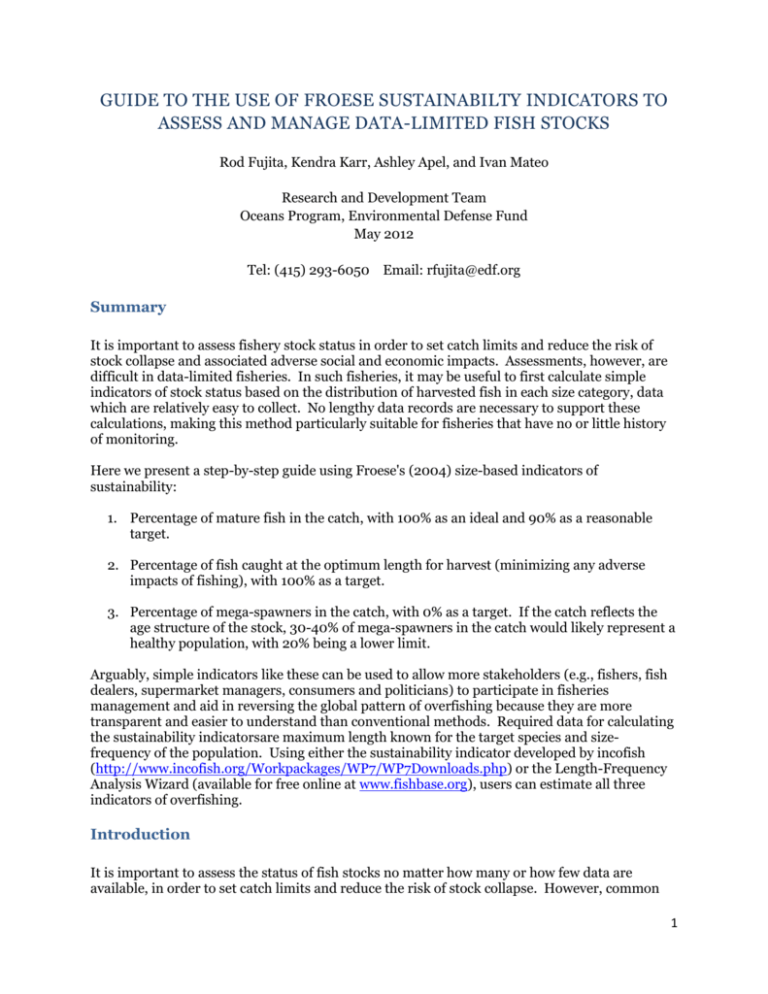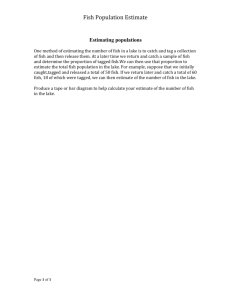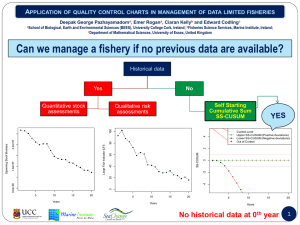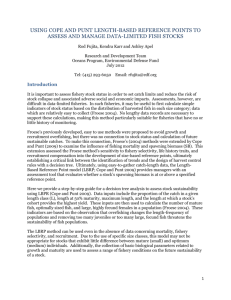Primer for Froese Sustainability Indicators of Overfishing
advertisement

GUIDE TO THE USE OF FROESE SUSTAINABILTY INDICATORS TO ASSESS AND MANAGE DATA-LIMITED FISH STOCKS Rod Fujita, Kendra Karr, Ashley Apel, and Ivan Mateo Research and Development Team Oceans Program, Environmental Defense Fund May 2012 Tel: (415) 293-6050 Email: rfujita@edf.org Summary It is important to assess fishery stock status in order to set catch limits and reduce the risk of stock collapse and associated adverse social and economic impacts. Assessments, however, are difficult in data-limited fisheries. In such fisheries, it may be useful to first calculate simple indicators of stock status based on the distribution of harvested fish in each size category, data which are relatively easy to collect. No lengthy data records are necessary to support these calculations, making this method particularly suitable for fisheries that have no or little history of monitoring. Here we present a step-by-step guide using Froese's (2004) size-based indicators of sustainability: 1. Percentage of mature fish in the catch, with 100% as an ideal and 90% as a reasonable target. 2. Percentage of fish caught at the optimum length for harvest (minimizing any adverse impacts of fishing), with 100% as a target. 3. Percentage of mega-spawners in the catch, with 0% as a target. If the catch reflects the age structure of the stock, 30-40% of mega-spawners in the catch would likely represent a healthy population, with 20% being a lower limit. Arguably, simple indicators like these can be used to allow more stakeholders (e.g., fishers, fish dealers, supermarket managers, consumers and politicians) to participate in fisheries management and aid in reversing the global pattern of overfishing because they are more transparent and easier to understand than conventional methods. Required data for calculating the sustainability indicatorsare maximum length known for the target species and sizefrequency of the population. Using either the sustainability indicator developed by incofish (http://www.incofish.org/Workpackages/WP7/WP7Downloads.php) or the Length-Frequency Analysis Wizard (available for free online at www.fishbase.org), users can estimate all three indicators of overfishing. Introduction It is important to assess the status of fish stocks no matter how many or how few data are available, in order to set catch limits and reduce the risk of stock collapse. However, common 1 methods for stock assessments may not be applicable to many fisheries due to the data-poor status of many species. In fisheries with minimal data on biological parameters (length, age distribution, etc.) and fisheries operations (historical landings, CPUE, among others), other approaches have to be used to estimate the status of fish populations. Here we provide a step-by-step guide to generating size-frequency data and calculating simple sustainability indicators using the method of Froese (2004). These indicators are based on the observation that overfishing changes the length-frequency of populations and that removing too many juveniles or too many large, fecund fish threatens the sustainability of fish populations. Description of Length-Based Sustainability Indicators The Froese overfishing indicators are: Let them spawn – measured as the percentage of mature specimens in the catch. Mature individuals are defined as those which have had a chance to spawn at least once. This is determined by the length at first maturity and converted into the length at which 90-100% of the fish of a given species is mature. The target is to let all (100%) fish spawn at least once before being caught (i.e., zero catch of juveniles) to rebuild and maintain healthy spawning stocks. Let them grow – measured as the percentage of fish caught at optimum length. Optimum length is where the number of fish in a given unfished year class multiplied by their mean individual weight is highest, resulting in maximum yield. Optimum length is typically a bit larger than length at first maturity and can be easily obtained from growth and mortality parameters or empirical equations (Froese and Binohlan 2000). The target is to have all harvested fish (100%) be within +/- 10% of optimum length (see Fig. 1). Let the megaspawners live – measured as the percentage of old, large fish in the catch (optimum length plus 10%). The target is to harvest no (0%) mega-spawners. If the catch reflects the age and size structure of the stock, however, 30-40% of megaspawners in the catch would likely reflect a healthy population; 20% of mega-spawners would be cause for concern and should be the lower limit. There are numerous examples of why large and older fish play an important role in the long-term survival of a population: 1. Large females are much more fecund because the number of eggs increases exponentially with length in most species; their eggs also tend to be larger, resulting in higher survivorship. 2. Reaching old age is usually a sign of overall individual fitness and thus mega-spawners are reservoirs and distributors of desirable genes. 3. Extending longevity and prolonging the reproductive phase can be viewed as a natural safeguard against subsequent recruitment failure. 2 Figure 1: Length-frequency data of Western cod landings from 1994-2001, where Lm indicates length at first maturity, Lopt indicates the length range where maximum yield could be obtained, and Lmax is the maximum size reached during that time (Froese 2004). Calculating Froese’s Indicators Step 1: Getting Started 1. Target Species: Identify a target species where you have length-frequency data from catch surveys and a good idea about the maximum length of the population (the largest fish caught during the past 5-10 years), either from fishermen’s observations or monitoring. If maximum length is unknown, data can be gathered from online resources such as FishBase but should be vetted as quickly as possible with fisherman interviews and/or field sampling. 2. Excel Spreadsheet: Use the Excel spreadsheet to keep track of the parts of the analysis and the results from the Length-Frequency Analysis Wizard, see attached (LF_Anlaysis.exl). 3. Length-Frequency Analysis: The Length-Frequency Analysis Wizard needed to perform these calculations is available online at FishBase (http://www.fishbase.org). The software is accessible by choosing a target species, then clicking length-frequency wizard under the Tools category. 3 Step 2: Input Data Input the following data into the Analysis Wizard: 1. Maximum length known for the population and the respective length type (total length (TL), standard length (SL), or fork length (FL)). Total length is needed to calculate natural mortality at a later stage. 2. Size-frequency of the catch The sampling program should be designed to ensure that the size class distribution is as broad as possible, preferably with data being obtained in all seasons (or including the seasons where there were more fishing activity reported ), from all fishing zones and including all types of fishing gear. Samples should be taken randomly from the catch, so that the samples will reflect the true size class distribution of the catch. Measurements should be done with reasonable precision. As a rule-of-thumb, a precision of 1 cm is adequate for species for which most fish are 30 cm or bigger. A precision to 0.5 cm at the time of measuring is fine for fish from 15 cm upwards, and so on for smaller individuals. Data should be grouped into length-classes of usually 20–40 groups. However, if fish sizes in size ranges are smaller, for example from 10 to 25 cm, a precision of 0.5 cm should be used (this will give 30 groups). The amount of sampling in a stratum (different areas, habitats, etc.) should be proportional to the contribution of that stratum to the total variability. More sampling will be required in fisheries and strata that have large landings or more variable sizes. Samples of the catch should be random and include at least 500 fish for each species, of the greatest variety of boats, gear types, and landing dates possible to maximize the range of lengths sampled. If the length-frequency data come from a single sample, the dataset should include at least 1,000 specimens. A good sample would be accumulated over a minimum of six months and include over 1,500 specimens. Additionally, monthly samples should contain roughly the same number of fish surveyed. Step 3: Length-Frequency Graph Once the maximum length and size-frequency data are entered, the Analysis Wizard provides the following: 1. 2. 3. 4. 5. 6. Length at optimum yield (Lopt) Length at first maturity (Lm) Number of specimens in the sample Number of mature fish in the sample Number of specimens at optimum yield (Lopt +/- 10%) Number of mega-spawners in the catch (Lopt + 10%) 4 7. Smallest fully selected length class 8. Average length in the sample The Analysis Wizard also provides an output graph that shows the length-frequency data with vertical lines depicting maximum length, length at first maturity, and length at optimum yield. The graph can be used to monitor progress toward specific management targets. Steps 4-11: Additional Information Steps 4 through 11 provide additional information on the target stocks; however they are not necessary to calculate the Froese overfishing indicators. These steps provide estimates of the sample yield in metric tons, growth, natural mortality, and fishing mortality. Step 11 calculates the difference in actual yield versus potential yield of the fishery under a management strategy that focuses on catching fish at the optimum length rather than harvesting juveniles or megaspawners. Such a management strategy would allow fish to produce before being caught, stabilizing recruitment and increasing catches in subsequent years. References Froese, R. 2004. Keep it simple: three indicators to deal with overfishing. Fish and Fisheries 5:529 86-91. Froese, R., and D. Pauly. 2012. FishBase. World Wide Web electronic publication: www.fishbase.org. Froese, R., and C. Binohlan. 2000. Empirical relationships to estimate asymptotic length, length at first maturity and length at maximum yield per recruit in fishes, with a simple method to evaluate length frequency data. Journal of Fish Biology 56:758-773. 5









